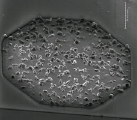Jan. 21, 2003 – NanoPierce Technologies, a Denver, Colo. company that has developed a patented method of connecting antennas to microchips, says it has signed an agreement with Avery Dennison Corp. “to explore the application of WaferPierce and NCS in the production of reliable, low-cost RFID labels.”
WaferPierce is NanoPierce’s method of depositing hard particles, such as diamond dust, on a metal surface. NCS stands for NanoPierce Connection System, which is used to create an electrical connection on a circuit board or between a microchip and an RFID antenna.
NanoPierce covers the hard particles with conductive material. The particles are then put on the metal pads of microchips before the silicon wafer is cut up into individual chips. After the wafer is cut, each chip is flipped over, pressed onto an antenna and bonded with nonconductive adhesive. The hard particles penetrate the glue and any dirt or film that might be on the antenna to create a direct, low-resistance bond.
“It’s basically a technology cooperation agreement,” Paul Metzinger, NanoPierce’s president and CEO, said of the arrangement with Avery. “We, at NanoPierce, anticipate that it will eventually develop into a commercial contract.”
Metzinger declined to reveal any details about the cooperative agreement, citing confidentiality requirements. He would say only that the agreement deals with “the development of protocols for the application of our technology to smart inlays.”
Avery, a sponsor of the Auto-ID Center, has been developing smart label technology. The company has a strategic partnership with Alien Technology, which is one of the pioneers of low-cost RFID based on the Auto-ID Center’s Electronic Product Code.
Avery has not gone public with information about smart label products because the company is still “getting its ducks in a row,” says Stan Drobac, Avery’s VP of RFID applications. Of the arrangement with NanoPierce he said: “We are continuing to look at new technologies, and this is one of them.”
The connection of the antenna to the chip is a critical step in the process of manufacturing RFID tags or labels. Metzinger claims that its technology can reduce the cost and speed up the process because the company uses non-conductive adhesives to bond the antenna to the chip.
Many existing methods use conductive adhesives, which take longer to dry. That slows down throughput and makes it harder to test the chip and connection. Many companies are exploring ways of speeding up the connection process because speed and volume are needed to reduced costs and produce enough chips to put on products in the supply chain.
NanoPierce has been seeking to license its technology to companies interested in producing RFID inlays. The company has a wholly owned subsidiary in Germany called Exypnotech, which uses NanoPierce’s connection technology to produce RFID tags for its customers.


